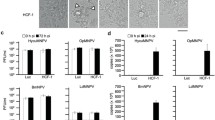Abstract
We have constructed a novel DNA expression vector based on Semliki Forest virus (SFV). SFV produces nonstructural proteins (nsPs) which replicate genomic RNA and amplify the mRNA encoding the structural proteins of SFV. A recombinant cDNA genome of SFV, in which the SFV structural genes were replaced by a polylinker cassette to allow for insertion of heterologous DNA, was placed under the control of a cytomegalovirus immediate–early enhancer/promoter with a polyadenylation signal. Transfection of mammalian cells with this SFV-based plasmid vector, pSFV3-CMV-lacZ-pA, resulted in transient high-level expression of a β-galactosidase reporter gene. The expression level of β-galactosidase from pSFV3-CMV-lacZ-pA was more than 20-fold higher than that obtained from the plasmid with deleted nsPs genes, pSFV3A5976-lacZ, demonstrating that the nsPs genes were essential for the high level of expression. Substantial β-galactosidase activity was detected in the medium of pSFV3-CMV-lacZ-pA-transfected cells, suggesting that the overproduction of β-galactosidase caused cell death and release of the protein into the medium. We have demonstrated a high-level expression of the exogenous β-galactosidase gene from pSFV3-CMV-lacZ-pA constructed using an SFV replication system.
Similar content being viewed by others
Author information
Authors and Affiliations
Rights and permissions
About this article
Cite this article
Kohno, A., Emi, N., Kasai, M. et al. Semliki Forest virus-based DNA expression vector: transient protein production followed by cell death. Gene Ther 5, 415–418 (1998). https://doi.org/10.1038/sj.gt.3300589
Received:
Accepted:
Published:
Issue Date:
DOI: https://doi.org/10.1038/sj.gt.3300589
- Springer Nature Limited
Keywords
This article is cited by
-
Properties and use of novel replication-competent vectors based on Semliki Forest virus
Virology Journal (2009)
-
Enhanced immunogenicity to food-and-mouth disease virus in mice vaccination with alphaviral replicon-based DNA vaccine expressing the capsid precursor polypeptide (P1)
Virus Genes (2006)
-
Immunization strategy against cervical cancer involving an alphavirus vector expressing high levels of a stable fusion protein of human papillomavirus 16 E6 and E7
Gene Therapy (2002)




